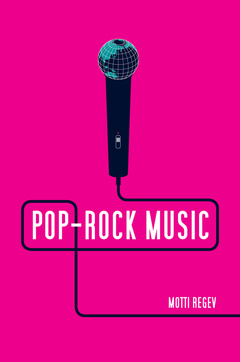Description
Pop-Rock Music
Aesthetic Cosmopolitanism in Late Modernity
Author: Regev Motti
Language: English
Keywords
Publication date: 06-2013
224 p. · 15.8x23.5 cm · Hardback
Publication date: 07-2013
224 p. · 15.2x22.9 cm · Paperback
Description
/li>Contents
/li>Readership
/li>Biography
/li>
Pop music and rock music are often treated as separate genres but the distinction has always been blurred. Motti Regev argues that pop-rock is best understood as a single musical form defined by the use of electric and electronic instruments, amplification and related techniques. The history of pop-rock extends from the emergence of rock'n'roll in the 1950s to a variety of contemporary fashions and trends ? rock, punk, soul, funk, techno, hip hop, indie, metal, pop and many more.
This book offers a highly original account of the emergence of pop-rock music as a global phenomenon in which Anglo-American and many other national and ethnic variants interact in complex ways. Pop-rock is analysed as a prime instance of 'aesthetic cosmopolitanism' ? that is, the gradual formation, in late modernity, of world culture as a single interconnected entity in which different social groupings around the world increasingly share common ground in their aesthetic perceptions, expressive forms and cultural practices.
Drawing on a wide array of examples, this path-breaking book will be of great interest to students and scholars in cultural sociology, media and cultural studies as well as the study of popular music.
Preface vii
1 Theories and Concepts 1
Aesthetic Cosmopolitanism: A Theoretical Framework 4
Characterizing Aesthetic Cosmopolitanism 6
Theoretical Framework 9
Rock, Pop, and Popular Music 17
Structure of the Book 23
Methodological Note 26
2 Expressive Isomorphism 28
Pop-Rock Styles and Genres 32
Pop-Rock Divas 33
Rock Auteurs 35
Progressive Rock 37
Punk and Metal 38
Electronic Dance Music 40
Hip-Hop 41
Ethnic Rock/New Folk 43
Dominance of the Musical Public Sphere 46
Legitimation Discourse 50
Ritual Classification: Tradition vs. Pop-Rock 52
Ritual Periodization: The “Birth of Rock” 54
3 A Field of Cultural Production 57
Working of the Field 59
Production of Meaning 61
Pop-Rock’s Ideology of Art 65
Mechanisms of Change and Innovation 75
Avant-Gardism 76
Commercialism 78
The Spiral of Expansion 80
Structure of the Field 83
National (Sub-) Fields of Pop-Rock Music 87
4 Long-Term Event of Pop-Rockization 91
Events 93
The Musical Event 95
The Historical Musical Event of Pop-Rock 96
Agency 97
Early “Pre-History” 106
Consecrated Beginning 108
Consolidation and Rise to Dominance 113
Diversification, Internationalization, Glorification 117
5 Aesthetic Cultures 123
Subcultural Scenes to Aesthetic Cultures 126
Aesthetic Cultures 129
Forms of Pop-Rock Knowledge 131
Early Participation 133
Global Microstructures 136
Internet Platforms 138
The Pop-Rock Intelligentsia 142
Indie/Alternative Pop-Rock 142
Alternative Pop-Rock on the Web 146
An Extended Case: Israeli Cognoscenti 148
6 Sonic Vocabularies, Spaces, and Bodies 158
Sonic Vocabularies 161
Tones and Timbres 162
Museme Stacks and Strings 165
Global Electro-Amplified Soundscapes 168
Aesthetic Cosmopolitan Bodies 172
Actants of Intercultural Phenomenological Proximity 177
References 180
Index 195




